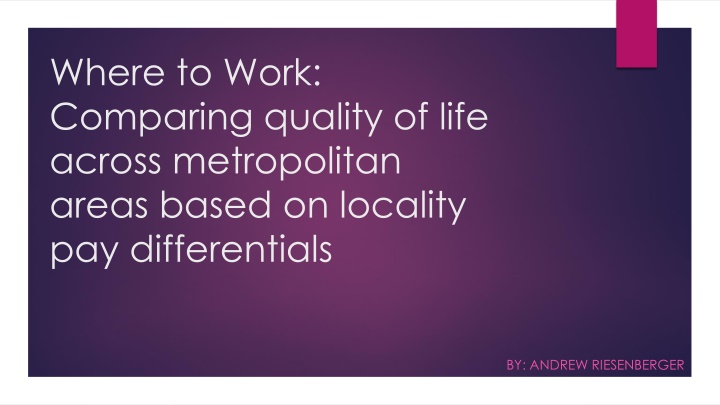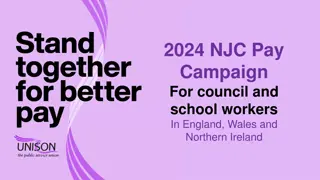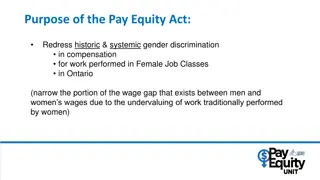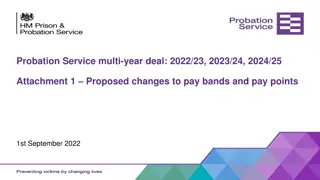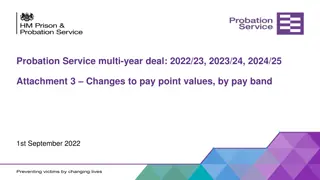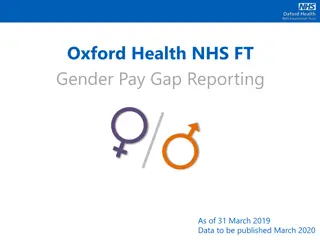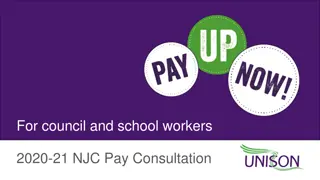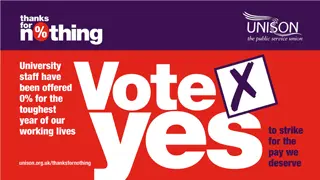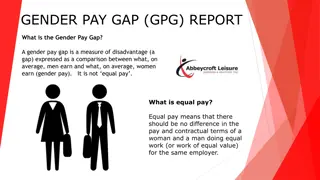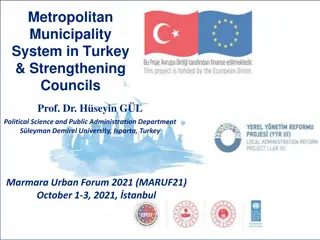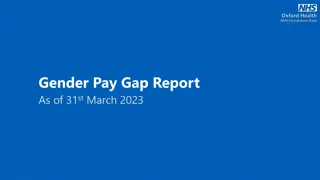Comparing Quality of Life in Metropolitan Areas Based on Locality Pay Differentials
This research project delves into the nuanced aspects of federal locality pay and its impact on the quality of life in different metropolitan areas. By analyzing compensation, cost of living, and quality of life measures, the study aims to identify favorable combinations for residents. Through a detailed methodology and expected results, the project seeks to provide valuable insights into the factors that drive migration within and between localities, shedding light on desirable micro-communities within larger areas.
Download Presentation

Please find below an Image/Link to download the presentation.
The content on the website is provided AS IS for your information and personal use only. It may not be sold, licensed, or shared on other websites without obtaining consent from the author.If you encounter any issues during the download, it is possible that the publisher has removed the file from their server.
You are allowed to download the files provided on this website for personal or commercial use, subject to the condition that they are used lawfully. All files are the property of their respective owners.
The content on the website is provided AS IS for your information and personal use only. It may not be sold, licensed, or shared on other websites without obtaining consent from the author.
E N D
Presentation Transcript
Where to Work: Comparing quality of life across metropolitan areas based on locality pay differentials BY: ANDREW RIESENBERGER
Agenda Background Overview of federal locality pay and why I chose this topic Goals and Objectives Understand the main drivers behind relocation Develop an index that accounts for compensation, cost of living, and quality of life for localities determined by the federal government Compare how this index relates to population change within localities Identify specific macro localities that offer residents favorable combinations of these metrics. Determine particular micro communities within larger localities that are most desirable based on prescribed metrics Literature Review Use research to describe the primary factors that drive migration from one locality to another and from one community to another within localities
Agenda (cont.) Methodology Discuss planned methods of analysis and data sources I ll be using Two different tiers of analysis: macro and micro level Steps taken in order to reach a conclusion Expected Results Anticipated Timeline Presentation Venue
Background (overview of federal locality pay and why I chose this topic) The Federal pay scale for regular employees is broken down into a table of 15 grades with 10 steps in each grade. Progressing from grade to grade often entails taking on a new position or role with a given organization and can be quite lucrative, especially in comparison to moving from step to step within a grade. Moving from grade to grade entails keeping the same position you re in and being compensated more with each step (as one becomes more experienced and perfects their craft), but compensation increases at a more gradual rate than moving up in grades.
Annual Rates by Grade & Step SALARY TABLE 2019-GS, INCORPORATING THE 1.4% GENERAL SCHEDULE INCREASE EFFECTIVE JANUARY 2019 www.opm.gov
Federal Locality Pay Locality pay is set by comparing regular Federal and non-Federal pay in each locality pay area, based on salary surveys conducted by the Bureau of Labor Statistics (BLS). There are 52 separate metropolitan locality pay areas. All other employees in the contiguous 48 States are included in the "Rest of U.S." (RUS) locality pay area, which makes the 53rd locality pay. BLS conducts a number of small-scale surveys in the RUS area and combines the results for setting the RUS locality pay rate.
Highest Locality Pay Area: San Jose San Francisco Oakland 40.37% Lowest Locality Pay Area: Rest of US Designation 15.37% Federal Locality Pay Areas. Each locality is composed of counties. Brighter localities are paid higher differentials than darker areas. www.federalpay.org
Project Motivation I am a Federal employee Many find themselves in situations where moving up in grades in or around their current location isn t quite so easy or plausible so they may be forced to relocate for a promotion this likely will pertain to me. I m Interested in drivers of migration there are countless reasons why people move, I wanted to determine what the most prominent reasons are.
Goals & Objectives Understand what factors typically motivate relocation Accomplished through literature review Develop an index that allows me to compare compensation with cost of living components in order to determine where Federal pay is relatively strong and relatively weak. Use data from a variety of sources and determine a method how they can be combined in a manner that reflects a certain pay to cost of living ratio.. Compare how this index relates to population change within Federally designated pay differential localities Which areas are growing/shrinking and how might population change trends be related to the quality of life index in that locality. Identify specific metropolitan localities that offer residents favorable combinations of these metrics. Where is population change occurring at the largest rate among the localities that have the most favorable quality of life metrics and what is special about these places? Determine particular micro communities within localities that are most/least desirable based on prescribed metrics Where are specific neighborhoods within a larger locality that offer the best characteristics Where are less desirable localities and how do they differ internally than more desirable locations
Literature Review Macro Migration Motivations People vote with their feet > move to the areas that best suit their preferences Two types of movements: temporary and permanent Going away to school vs. moving for good Relocation tends to be a behavior exhibited more often by the affluent. They can afford to go away to school. This creates a ripple affect. What are primary drivers of relocation from one region to another? Job search and opportunity to earn more Align oneself ideologically/politically with others who share common beliefs Consume less (spend less/downsize) 55% of individuals in a particular study identified this as their main cause of moving Millennials tend to relocate more often (mid/late twenties, some post-high school education, not home owners, marital status of separated )
Literature Review Micro Migration Motivations Community selection and satisfaction are multi-dimensional The environment one grew up in is positively correlated to the type of environment one prefers Younger individuals tend to be more open to moving than the elderly Accessibility to amenities is a huge factor Proximity to recreation, (better) schools, shopping, and hospitals A sense of community People want to engage with neighbors but still have their own privacy A connection with natural landscapes Lower crime Proximity to large cities Suburbs tend to be the eventual destination of choice as it offers a favorable balance
Proposed Methodology Utilize data from the Census Bureau (Decennial Census, American Community Survey) and MIT in order to capture cost of living metrics. Develop an index that provides a ratio of cost of living metrics against federal pay in Federally defined localities. Main factors that I ll be using to develop index: housing costs (average rent/median home price), commute times, crime frequency, income data. Compare localities in terms of their ratio values on a national scale and measure this against population change (macro level) Examine a subset of selected localities with varying ratio values and evaluate community characteristics on a tract level. Create a series of maps that help visualize how these different factors compare with population change across and within federally-defined localities
Proposed Methodology (cont.) Determine specific communities within the larger localities provide the residential option in terms of costs and salaries by using data from the ACS at the tract level.
Challenges Faced I believe the biggest challenge I will face is developing a certain index for how the different costs of living metrics are weighted in relation to one another. People value things differently than others, so it may be hard to account for these variances.
Anticipated Results I believe the localities that provide the most favorable value in terms of costs incurred and salary earned will not be the localities that offer the highest salaries I believe better value will be found in neighboring areas that have similar locality differentials but much more affordable housing prices, even if their index figure may suffer from longer commute times. I believe that some of the localities that boast the highest population increases (in part by attracting new residents) will have some of the poorer ratio figures.
Project Timeline Between now and my conference presentation (November 23-26, 2019) Synthesize all applicable spatial and tabular data and conduct analysis Generate an index that accounts for costs of living, income, quality of life metrics Create maps, describe analysis and conclusions, and be prepared to present my methods and my results at the conference. Plan to have all analysis and deliverables completed by the end of August, 2019.
Presentation Venue Southeastern Division of the American Association of Geographers conference November 23-26, 2019 UNC Wilmington, North Carolina Submittals for project abstracts will be due in early summer
